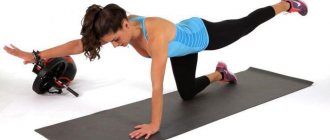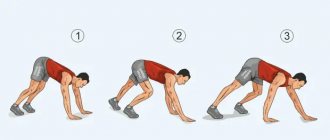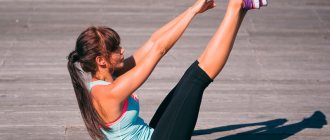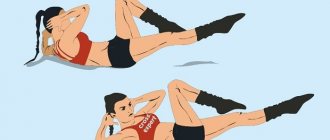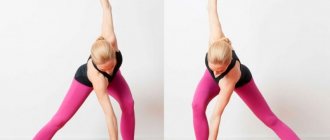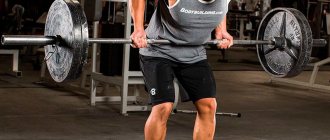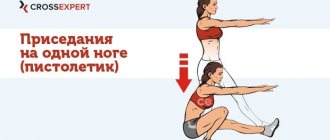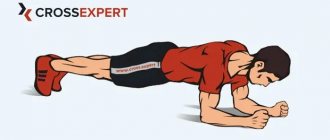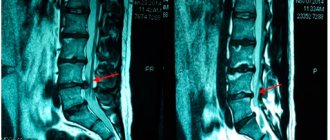The gymnastic exercise “Swallow” develops balance, makes posture more even and helps develop coordination. The movement is often used as a general physical training exercise for children involved in dancing, and as one of the elements of physical education. That’s why it is familiar to us from childhood. But in adulthood, many cannot maintain balance in a one-legged stance. Why does this happen, and how to quickly learn how to make a “swallow”?
Benefits of exercise
This exercise is universal. It is suitable for people of all ages and can provide benefits across a wide range of physical development levels. It will help beginners to strengthen their buttocks and back, while those who are “continuing” will work on their balance. “Swallow” helps develop dexterity, and can be considered an exercise useful in preventing injuries.
The main advantages of including “swallow” in your routine:
- strengthening the gluteal muscles and hamstrings;
- improved posture;
- development of balance and endurance;
- strengthening the abdominal muscles, as the abs work statically;
- stretching the long back muscle;
- improved blood circulation;
- prevention of pain due to hernias and osteochondrosis
The exercise does not create an axial load on the spine and does not increase compression. It allows you to fully load the muscles of the posterior chain, and at the same time stretch the muscle along the spine.
The movement is considered beneficial for both men's and women's health. In men, it can serve as a prevention of prostatitis, as it improves circulation in the pelvic area. In women - prevention of various diseases of the genital area. However, the movement does not provide any particular benefit in this regard. It should be performed as part of a complex of gymnastic exercises and can be replaced by other movements that develop the core, hamstrings, and buttocks.
The exercise is not universal. It uses muscles in a static mode, allowing you to strengthen them, increase tone, but not increase volume. Therefore, it is unlikely that you will be able to pump up your buttocks or correct your posture with this movement. Another drawback is that many people do the exercise incorrectly. It is enough to choose the wrong angle and the movement will turn into a general strengthening exercise for the hamstrings or even a way to overload the hamstrings.
FAQ
Will exercise therapy help you recover faster after a hernia removal?
Is it possible to do exercise therapy for Schmorl's hernia? Yes. Exercise therapy can be done for any type of hernia, when the acute pain subsides. The main thing is to choose the right set of exercises. If you have a Schmorl's hernia, you definitely need to pump up and strengthen the muscles, especially the back and abdomen. It is important to remember: weight bearing is contraindicated.
Is it possible to do exercise therapy for a sequestered hernia?
It is possible, but we must proceed from the fact that exercise therapy cannot be done during the acute phase. When the pain subsides, light exercise is allowed after consulting a doctor. Water gymnastics gives a good effect.
Topics Herniated disc, Spine, Pain, Treatment without surgery Date of publication: 11/12/2020 Date of update: 03/16/2021
What muscles work
The main ones are:
- hamstrings, glutes, posterior chain muscles, and deltoids;
- calves, quads and abs provide stabilization;
- The transverse abdominal muscles also work as stabilizers.
The exercise loads many small muscles, from the neck muscles to the foot muscles. It is considered complex, but at the same time it does not contribute to pumping, it simply strengthens and tones.
Basic figures in gymnastics
This is general information and should not be confused with advice. Talk to a specialist about all your health-related issues and ask for their advice. Children must be supervised by adults at all times. We disclaim all liability for any physical damage caused by the information on this website. For more information, please see our disclaimer and privacy policy.
There are several basic forms and body positions that are repeated over and over again in gymnastics skills. Learning and then perfecting the forms is a great way to practice and improve gymnastics at home.
We're going to discuss each form, why it's important, and some of the skills that will require you to do it. That's…
That's…
Tuck: You see the tuck form at each of the competitions. As beginning gymnasts, you perform tuck jumps and then tuck jumps with a twist on both floor and beam. As you progress, you will learn how to make a front dart. On the bars you will use the tuck shape as you go to do a flap and then a twist or double flap. On the vault, as an advanced gymnast you will learn the tsuks fold and other flipping vaults.
Straddle: The straddle jump is a jump you will perform as a beginning gymnast, it is a level 4 exercise all the way up to an advanced gymnast. As you progress in gymnastics, you will learn standing half-turn and full-turn jumps, as well as standing jumps on the balance beam. You can also see the straddle form in different skills, such as the handstand of the straddle press or the transition to handstand on the bars.
Pike: You see the shape of the pike in each of the competitions, just like the grouping. You will learn to jump while bending over on the floor and on a beam. And as you progress through the floor, you'll learn to dig into the back and front after you learn the tuck versions. On bars you can see the pike shape in many different skills including kip. There are many different inverted vaults that use the pike shape.
Split: The split figure appears constantly on the floor and beam in gymnastics! The floor split is a key part of a gymnast's flexibility. Starting at Level 1, a split jump is required on each of the required floor or beam levels. After learning double jumps, gymnasts practice double jumps and then change it up.
Straight stance: Straight stance, or straight body position, is EVERYWHERE in gymnastics. This is the most important position to master. As a gymnast, you should be able to stand with your butt squeezed, thighs tight, core tight, arms straight and behind your ears.
Handstand: A handstand is basically a straight, upside-down position of the body. The handstand is another pose that is found in gymnastics. On both floor and beam, you can perform regular handstands and hand presses. On the arch, you can make front handsprings, which has a stand on the storage table in the middle of the craft. And on the uneven bars you can do handstands in a cast.
Lunge: The lunge is how you finish most acro skills on floor and beam. You will land in a lunge from a handstand, cartwheel, front flip, back flip, etc.
In a lunge, it is important to keep your back leg straight and your front leg bent, with your glute and core contracted. You want your arms to be straight and right next to your ears.
Arch: In gymnastics, it is important to learn how to control the muscles in your body and learn these basic forms. One of the main shapes you need to learn to control is the arch. A tight arch shows up in many skills, and moving from arch to cavity gives your body strength
One of the skills that requires your body to transition from arch to cavity is the back spring. When you are in an inverted position on the backspring, you will be in an arc with your feet behind your head. As you extend your legs over your head to pop out of the spring, your body will move into the depression.
Hollow: The opposite shape of the arch is the hollow shape. In the hollow shape, you want your bottom and core to be compressed and your legs to be pressed together while they are slightly in front of you. You may feel a cavity when doing boat conditioning exercises on the ground.
Bridge : The bridge is another basic gymnastics form. When you are on the bridge, you need to push your body forward to stretch your shoulders. The basic skill where you use the bridge is to flip the bridge.
Obviously there are other forms of gymnastics, but these are the simplest. Practicing these figures with good form is a great way to improve your gymnastics.
Technique for standing on one leg
This version of the “swallow” is considered a classic. It is performed standing on one leg, and specifically works the hamstrings and buttocks.
The exercise is performed as follows:
- stand straight, shift your weight to your right leg;
- ha account for flexion at the hip joint, bend over, let the spine be parallel to the floor;
- then tighten your stomach and stretch your arms to the sides;
- hold the “swallow” position for 8-10 seconds;
- fix the body rigidly by retracting the abdomen;
- try to actively engage your muscles
At the end, reverse the movement, straighten your body, place your other leg on the floor, straighten up, repeat on the other leg. The exercise can also be performed with arms extended forward.
Exercise “Swallow” for balance and strengthening the muscles of the back and legs
Various problems and technical errors
- The main technical error is rounding the back. The reason may be either insufficiently active muscle activation or insufficient flexibility and mobility in the hip joint. If the reason is a lack of flexibility, do the exercise after a small stretch of the hamstrings and calves;
- The inability to hold your arms statically, their “falling” is a weakness of the back muscles, not the arms. You need to gather your shoulder blades, pull in your stomach, and keep your arms in the same plane as your spine;
- In addition, it is not recommended to “drop” a leg that is raised. This leg “falls” due to insufficient engagement of the gluteal muscles. It is necessary to consciously reduce them throughout the exercise;
The inability to maintain balance is caused by an artificially placed foot. Ideally, the toe should be pointed slightly to the side, so that the position of the foot is stable.
About position in motion
Any movement of the upper limbs is a way to change the position of the arms. Such changes can be of two types:
- one-sided;
- circular.
One-sided intermediate positions should not be understood as changes in the position of only one hand; the movement can be performed by both. The essence of the name of these positions is that the movement does not occur in a circle, but in any direction.
All one-way positions in movement combine movements in the following directions:
- left;
- right;
- top;
- bottom;
- forward.
Circular changes in the position of the hands are characterized by an arcuate movement, which is why they differ from unilateral ones.
Down on my knee
This variation places a significant portion of the load on the back. Get on all fours, extend your opposite arm and leg, and leave them on the floor, and then:
- as if stretch to the sides and raise your arm and leg to the plane of the floor;
- bring your shoulder blades toward your spine;
- pull your stomach in;
- tense your arm and leg;
- stay in this position for 8 to 20 counts, then relax and lower your arm and leg to the floor;
- switch sides, repeat.
How much and how to do it
Take a breath and repeat at least 4 times. Every day, increase the number of repetitions and the time spent in statics. If you find it difficult to work with full amplitude, experiment with the height of your torso.
The breathing mode does not matter. However, before you begin the process, do a breathing cycle that will help disperse the blood. As you inhale, pull your stomach toward your spine, and as you exhale noisily, push it out. In the exercise, lifting can be done while inhaling and exhaling; at the climax, the breath is held involuntarily.
For girls with curvy figures, it is not very convenient to perform the “swallow”; for convenience, try rolling up a towel with a roller and placing it in the solar plexus area.
Sources
- https://bestlavka.ru/kak-pravilno-delat-uprazhnenie-lodochka-dlya-spiny/
- https://ProstoFitness.com/baza-uprazhnenie/drugie/lodochka-dlya-spiny.html
- https://upraznenia.ru/giperekstenziya-na-polu-ili-lodochka.html
- https://kachajsya.ru/uprazhneniya/uprazhnenie-lodochka.html
- https://zhenskoe-mnenie.ru/themes/health/uprazhnenie-lodochka-kak-delat-pravilno-i-maksimalno-effektivno-dlia-organizma-prorabotka-trudnodostupnykh-myshts-s-pomoshchiu-uprazhneniia-lodochka/
- https://bodybuilding-and-fitness.ru/zanyatiya-sportom-dlya-nachinayushih/fitnes-doma/uprazhnenie-lodochka.html
- https://bodysportal.ru/uprazhneniya/lodochka/
- https://fitnessi.ru/ochen-effektivnoe-i-poleznoe-dlya-spiny-uprazhnenie-lodochka/
- https://spina.guru/raznoe/uprazhnenie-lodochka-spiny
- https://sportfito.ru/publication/uprazhnenie-lodochka/
Technique lying on your stomach
This exercise is completely designed to work the back muscles.
Lie on your stomach, tuck your stomach, tense your arms, extend them along your body, and then:
- lift your legs and body off the floor at the same time;
- by drawing in the abdomen, keep the arch in the lower back shallow;
- tense your arms, pull your shoulder blades towards your spine;
- hold this static position for as long as you can. Repeat as many times as necessary.
48. Swallow. Working out the back extensors
Paper SWALLOWS (20 crafts) for children.
Good afternoon, in this article you will find all the ways to make a swallow from paper with your own hands. There will be applications made of paper with a swallow, birds made of cardboard (voluminous swallows), and bulk applications made of semolina. I will also give templates and stencils of the most beautiful silhouettes of swallows. In short, all the ideas for spring crafts on a bird theme are collected in one article - so as not to scour all over Google.
We also have an article - where we make a variety of birds from paper (not just swallows) - BIRDS from paper (55 crafts for children).
So, let's see how to quickly and easily make a swallow from scrap materials (paper and cardboard) with your own hands...
Swallow applique.
From paper we cut out silhouettes of swallows, silhouettes of a white breast and beak. You can use the paper half-disk technique (as in the right photo below). A suitable spring craft for kindergarten.
Craft for kindergarten.
In the photo below we see how interesting the swallows look from below when they are sitting on the wires.
Here is a three-dimensional applique that repeats this image from the photographs. The usual black paper details and white loops of white stripes are like the arched breasts of birds.
You can add any elements to this application. Rain, sun, foliage, flowers.
You can make a bulk applique from colored semolina. We paint semolina in different colors using a dry method using powdered food coloring.
With paper swallows.
In kindergarten or in a circle, skillful hands can make a great craft. Collective panel. Cut out silhouettes for swallows from black cardboard and decorate them with white and red gouache.
Stencil templates with swallows will be lower in this article and now I will also give a few.
You can zoom in on your screen. Place a sheet of paper directly on the screen and trace with a pencil a drawing that will glow through the paper. You can enlarge or reduce the image on the screen by holding the Ctrl button and turning the mouse wheel.
Paper swallows.
Here is a simple craft-spring postcard with two paper swallows.
And if these same silhouettes are cut out of cardboard, then they can be hung on a string. Make a hanging module like this with paper swallows.
You can interestingly design a cardboard silhouette of a swallow craft. For example, make a nest with eggs. Attach a midge made of paper to the beak (not a worm, swallows do not eat them). Only midges, which they catch in flight, are swallows’ favorite delicacy.
And if you add white repeats to this black silhouette - but in a slightly smaller size, so that the black silhouette is visible around the edges - you will get a real Lao girl. And also make a white boa in the neck area. It turns out to be a very beautiful craft - and at the same time simple for a kindergarten of the younger group.
By spring there is always a lot of black cardboard left over that you don’t know where to put, and there is also white landscape paper. And here’s an idea for a budget-friendly and simple craft just for such a case.
Here are some beautiful stencil templates for similar crafts.
You can make several swallows from black cardboard. Glue a white breast and a red neck to them. And hang it from the ceiling. As a reminder that spring is outside the window and we need to rejoice and believe in the best new, fresh, unexpected, but long awaited.
Swallow tongue
Brehm argues that the languages of European swallows are as different from one another as German is from Portuguese. The barn swallow dialect is the most developed, and although it is unlikely that the Illiad could be created in it, this dialect still opens up significant possibilities.
Fans of linguistics, for example, will be pleased to know that “fuit” means “fly here!”, and “fuit-fuit!” - “come here quickly!”; “uirb-uerb” corresponds to the command “rise!”, “yu-yu-yust” warns: “attack!”, “deulik” calls: “be careful!”. And the “tsech-tsech” sound made by the tremolo gives a general alarm: “save yourself who can!” Of course, only individual signals have been decrypted
As for the more complex phrases uttered by swallows in flight, they are still waiting for their translator. For comparison, we point out that the language of city swallows is much more restrained and is usually limited to simple “skru-skru” (“come here”) and “ski-i-r” (“I’m afraid!”)
Of course, only individual signals have been deciphered. As for the more complex phrases uttered by swallows in flight, they are still waiting for their translator. For comparison, we point out that the language of city swallows is much more restrained and is usually limited to simple “skru-skru” (“come here”) and “ski-i-r” (“I’m afraid!”).
The remaining varieties are even more silent. The mountain swallow chatters with its friend with a simple “dui-dui-dui”, and when it calls its flying spouse, it makes do with the primitive “dru-dru-dru”. That's all. As for the shore swallows, they, due to insufficient linguistic development, did not end up on the magnetic tape of hunters for the voices of wildlife.
